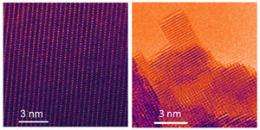Batteries: Scientists see how and where disruptive structures form and cause voltage fading

(Phys.org)—Starting as a few atoms long, thorns forming on the electrode's surface in a specialized lithium battery cause the battery to gradually fade, according to scientists at Pacific Northwest National Laboratory (PNNL) and Argonne National Laboratory. Working with powerful imaging technologies in DOE's Environmental Molecular Sciences Laboratory (EMSL), the team determined that a kind of thorn with the crystallographic spinel structure grows out of the electrode material and eventually leads to the complete conversion of the whole electrode material into the spinel structure. Furthermore, growth of this spinel structure liberates lithium oxide molecules, causing cracking and pitting. The damaged electrode thereby fades, releasing less energy with each charge/discharge cycle.
"The changes to the structure are pretty subtle after each cyclic charge/discharge of the battery," said Dr. Chongmin Wang, a PNNL researcher who led the study. "Atomic-level imaging provides the opportunity to get a fundamental picture of how does this type of subtle change evolves."
Increasing our nation's independence from fossil fuels for our transportation fleet requires energy storage. A lithium-rich layered composite could increase batteries' energy density by more than 50 percent. However, the battery fades. With repeated use, the voltage and amount of energy that can be reversibly stored and released gradually declines. The cause is a change or transformation in the composite, but how and where the transformations or phase transitions occur was under debate. By taking and analyzing atomic-resolution images of the battery's electrode before and after use, the team answered the questions.
"These findings and the follow-on studies are critical for applications, including energy storage and electric vehicles," said Dr. Jun Liu, a key player in the Joint Center for Energy Storage Research and a PNNL materials scientist on the study.
The team began with layered lithium battery electrodes, where the layers are just a single atom thick. The material was synthesized at Argonne, where it was invented several years ago. The research team used a new energy dispersive spectrometer (EDS) and a powerful scanning transmission electron microscope to obtain detailed chemical composition and atomic structure information on the electrode materials. The FEI Company, in Hillsboro, Oregon, supplied the EDS. The company was looking for outstanding examples to showcase the power of their instruments. Using the EDS spectrometer, the team identified chemical inhomogeneity and its correlation with the phase changes that occurred in the material.
The team used a new electron microscope located in EMSL to obtain atomic-resolution images. "The high-resolution work is cutting-edge imaging research," said Dr. Nigel Browning, Chief Scientist in Microscopy for the Chemical Imaging Initiative at PNNL and researcher on this study. "It is a fantastic application of atomic-resolution microscopy techniques, and it confirms that spinel formation can account for the origin of voltage fading by determining the exact location of the spinel, and how the whole structure fragments as the spinels are formed."
Many of the people on this project are working to find new ways to synthesize and stabilize the materials in the layered lithium battery. "We are working as a team to take it to the next level - in situ images. We want to see the changes at the atomic level as they occur," said Wang.
More information: Gu, M. et al. Formation of the Spinel Phase in the Layered Composite Cathode Used in Li-Ion Batteries, ACS Nano. Article ASAP. DOI: 10.1021/nn305065u
Journal information: ACS Nano
Provided by Pacific Northwest National Laboratory




















